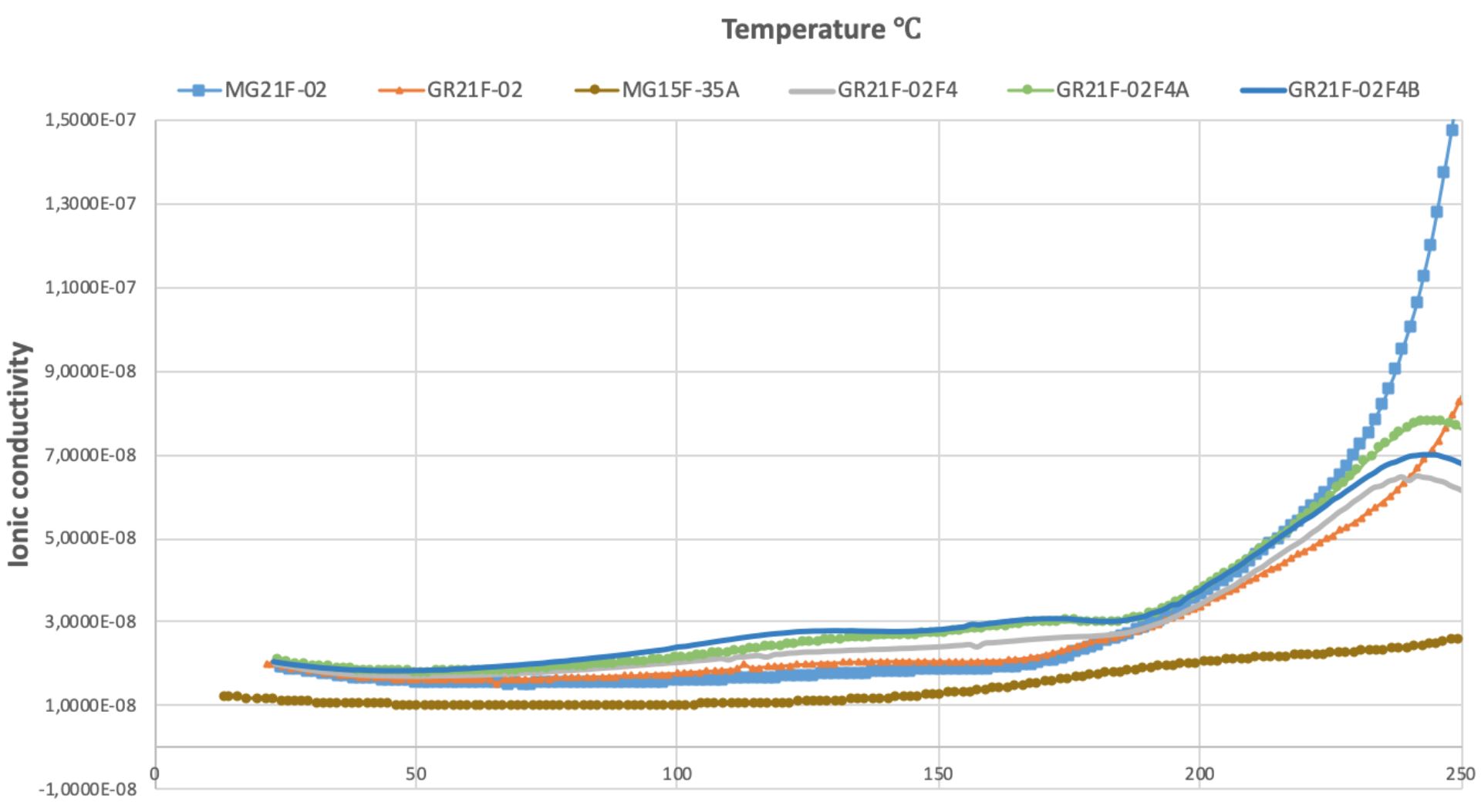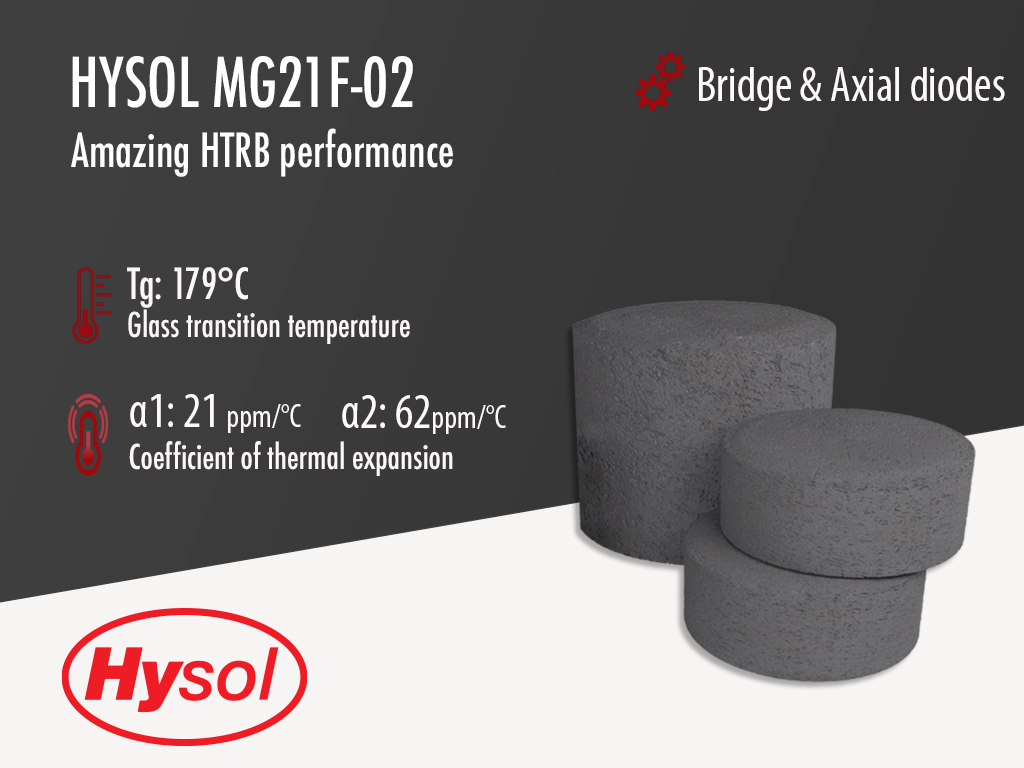Hysol MG21F-02 | Black Epoxy Mold Compound
- Amazing HTRB performance
- Excellent adhesion to Sn, Si and Cu
- Encapsulation of low voltage diodes
Product Description
Hysol MG21F-02 is a high productivity, low cost, epoxy molding compound, designed specifically for high volume encapsulation of low voltage diodes and small signal transistors. It offers excellent reliability & HTRB data and has been used for diode bridge, axial diodes, diode metal electrode leadlesss face (MELF) and other high voltage and discrete semiconductor packages. It offers excellent adhesion to Sn, Si and Cu and amazing HTRB performance.
Hysol MG21F-02 performs very well during high-temperature reverse bias testing for devices running up to 800V and at 150°C. The largest cause of failure of epoxy molding compounds on these devices is the result of gate leakage and then ultimately catastrophic run-away current when tested under bias at temperature. MG21F-02 performs very well under these conditions. The CTI (comparative tracking index) of the MG-21F-02 is 325V.
Hysol MG21F-02 was developed many years ago, but is still one of the best EMC on the market for diodes, bridges and high voltage diodes. Many competitors have tried and failed to compete against this MG21F-02. Those that did manage to meet the same performance targets as the MG21F-02 did so at prices that were nearly twice that of the MG21F-02, leaving this product leading with an excellent price/performance correlation. Typical applications and uses of MG21F-02 include but are not limited to 28, 28 and 56 pin DL TSSOP, SOT, SOIC, PDIP and other power discrete and high voltage semiconductor packages.
We are currently developing the Green version of this product, to ensure it does not contain TBBP-A or antimony trioxide while also maintaining its flame retardant and electrically stable properties. Contact us for more information.
Technical Specifications
| General Properties | |||||||||||
| Color Color The color | Black | ||||||||||
| Filler Content | 71 % | ||||||||||
| Specific Gravity Specific Gravity Specific gravity (SG) is the ratio of the density of a substance to the density of a reference substance; equivalently, it is the ratio of the mass of a substance to the mass of a reference substance for the same given volume. For liquids, the reference substance is almost always water (1), while for gases, it is air (1.18) at room temperature. Specific gravity is unitless. | 1.81 | ||||||||||
| |||||||||||
| Physical Properties | |||||||||||
| Spiral Flow @ 175°C | 65 cm | ||||||||||
| Chemical Properties | |||||||||||
| |||||||||||
| Moisture absorption | 0.22 % | ||||||||||
| Electrical Properties | |||||||||||
| |||||||||||
| Volume Resistivity Volume Resistivity Volume resistivity, also called volume resistance, bulk resistance or bulk resistivity is a thickness dependent measurement of the resistivity of a material perpendicular to the plane of the surface. | 2.0x1016 Ohms⋅cm | ||||||||||
| Mechanical Properties | |||||||||||
| |||||||||||
| |||||||||||
| |||||||||||
| Molded Shrinkage | 0.23 % | ||||||||||
| |||||||||||
| |||||||||||
| Thermal Properties | |||||||||||
| |||||||||||
| |||||||||||
| Glass Transition Temperature (Tg) Glass Transition Temperature (Tg) The glass transition temperature for organic adhesives is a temperature region where the polymers change from glassy and brittle to soft and rubbery. Increasing the temperature further continues the softening process as the viscosity drops too. Temperatures between the glass transition temperature and below the decomposition point of the adhesive are the best region for bonding. The glass-transition temperature Tg of a material characterizes the range of temperatures over which this glass transition occurs. | 179 °C | ||||||||||
| Thermal Conductivity Thermal Conductivity Thermal conductivity describes the ability of a material to conduct heat. It is required by power packages in order to dissipate heat and maintain stable electrical performance. Thermal conductivity units are [W/(m K)] in the SI system and [Btu/(hr ft °F)] in the Imperial system. | 0.7 W/m.K | ||||||||||
| UL 94 Rating UL 94 Rating Flammability rating classification. It determines how fast a material burns or extinguishes once it is ignited. HB: slow burning on a horizontal specimen; burning rate less than 76 mm/min for thickness less than 3 mm or burning stops before 100 mm V-2: burning stops within 30 seconds on a vertical specimen; drips of flaming particles are allowed. V-1: burning stops within 30 seconds on a vertical specimen; drips of particles allowed as long as they are not inflamed. V-0: burning stops within 10 seconds on a vertical specimen; drips of particles allowed as long as they are not inflamed. 5VB: burning stops within 60 seconds on a vertical specimen; no drips allowed; plaque specimens may develop a hole. 5VA: burning stops within 60 seconds on a vertical specimen; no drips allowed; plaque specimens may not develop a hole | V0 | ||||||||||
| Curing Conditions | |||||||||||
| |||||||||||
| |||||||||||
| Transfer Pressure | 35 - 105 kg/cm2 | ||||||||||
| Transfer Time | 12 - 25 s | ||||||||||
Additional Information
Comparison of MG21F-02 with new Halogen-Free, Green GR21F-02 formulations

MG21F-02 | GR21F-02 | GR21F-02F4 | GR21F-02F4A | GR21F-02F4B | ||
|---|---|---|---|---|---|---|
Formula Enhancement | Flame Retardant | TBBP-A & Antimony Trioxide | Not Contained | Green Flame Retardant X | Green Flame Retardant X+ | Green Flame Retardant X+ |
Ion Capture | Not contained | Not Contained | Ion Capture A Ion Capture B | Ion Capture A Ion Capture B | Ion Capture A+ | |
Expectation | Halogen-free | - | ✓ | ✓ | ✓ | ✓ |
UL94 V-0 (1/8 inches) | ✓ | - | ✓ | ✓ | ✓ | |
Improved Electrical Stability | ✓ | - | ✓ | ✓ | ✓
|
Comparative Tracking Index
Test method: WI HHE Q A.6-124 (3.0mm Thickness)
| Voltage (V) | # | Drop To Track | Oservation | Average |
|---|---|---|---|---|
300 | 1 | 100 | Eroded | 100
|
| 2 | 100 | Eroded | ||
3 | 100 | Eroded | ||
| 4 | 100 | Eroded | ||
| 5 | 100 | Eroded | ||
350 | 1 | 86 | Eroded | 48
|
2 | 10 | Flamed | ||
325 | 1 | 100 | Eroded | 100
|
2 | 100 | Eroded | ||
| 3 | 100 | Eroded | ||
| 4 | 100 | Eroded | ||
| 5 | 100 | Eroded |
CTI(V) = 325
Customer reliability tests - Not Hysol Specifications
Diode type: TVS 500V/1,5μA
- Standard Assembly process
- HTRB test / Reliability
- Temperature: 140°C
- Reverse Bias: 375V
- Duration: 24h
Compound / Colour Code | Molding Temperature (°C) | Transfer Time (sec) | Curing Time (sec) | Pre-heating (sec) | Post-Curing (h) |
Product A | 190 | 15 | 110 | 25 (0.4A) | 8 @ 175°C |
MG21F-02 | 185 | 25 | 60 | 24 (0.4A) | 6 @ 175°C |







